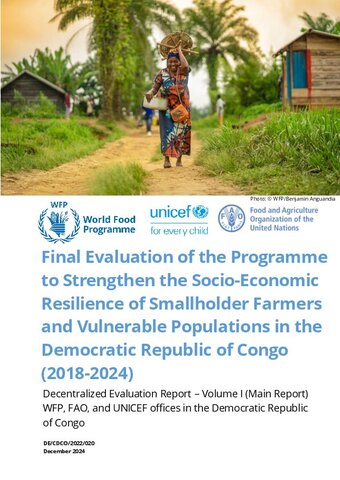
Conducted from 2023 to 2024 and led by WFP, the evaluation aimed to generate evidence for the next phase of the JRP, focusing on accountability and learning. It assessed the relevance, effectiveness, efficiency, impact, sustainability, coherence, and contributions to gender equality, human rights and inclusion. Collectively, the evaluation questions are intended to highlight key lessons and programme performance that could inform strategic and operational decisions. The evaluation covered areas such as school feeding, resilience, agriculture production, asset creation and livelihoods, food security, smallholder agricultural market support, institutional capacity strengthening, malnutrition prevention, water, sanitation and hygiene, gender equality, and social cohesion and peacebuilding.
Key evaluation findings included:
- The JRP aligns well with the national priorities, BMZ, and the implementing agencies, and effectively addresses the needs of smallholder farmers through seeds, agricultural training, and market access activities. However, while the program’s multisectoral approach was perceived as comprehensive and appropriate for the needs of vulnerable communities in North and South Kivu, the numerous activities, made it logistically challenging, resulting in only 50% of planned activities being fully implemented.
- Although access to improved sanitation and water sources remains generally low, significant improvements in WASH facilities at health centers and schools were attributed to the JRP.
- Households with women in VSLAs had higher food consumption and dietary diversity scores and grew more crops. Smallholders who received cultivation training reported increased yields and the ability to use crops for both household consumption and market sale.
- The three agencies monitored the JRP with dedicated M&E teams and regular field missions. However, there was limited coordination and alignment in their efforts.
- JRP activities have contributed to stabilization and peacebuilding, though their impact on resilience in other areas remains unclear. Participants noted that ongoing efforts could enhance resilience in health, gender equality, and livelihoods, with potential benefits for other sectors.
Key recommendations from the evaluation included:
- Convergence of programme interventions or “activity layering” is needed both in terms of implementation to ensure individuals have access to multiple complementary interventions.
- Focus on elements needed for full implementation of activities, such as the level of accessibility, stability and a smaller number of interventions, as well as their sustainability, such as government ownership.
- Increase coverage of peacebuilding activities in communities beyond specific individuals or groups.
- To enhance organizational learning and track program impacts effectively, agencies should align their evaluation and Monitoring & Evaluation (M&E) strategies based on shared learning objectives. This includes incorporating elements of convergence and adopting unique identifiers across activities to enable precise tracking of program convergence at the household level.
- Strengthen local agriculture through strategic crop selection and reinforce farmers’ knowledge and practice in natural resource management and climate resilient agricultural production.
- Establish a coordination mechanism for community-level NGO partners to connect, coordinate activities, and avoid duplication of effort.
- Increase communication and transparency around the JRP’s targeting rationale at the community level, develop a structured approach for including vulnerable populations and continue efforts to increase women’s access to credit.
